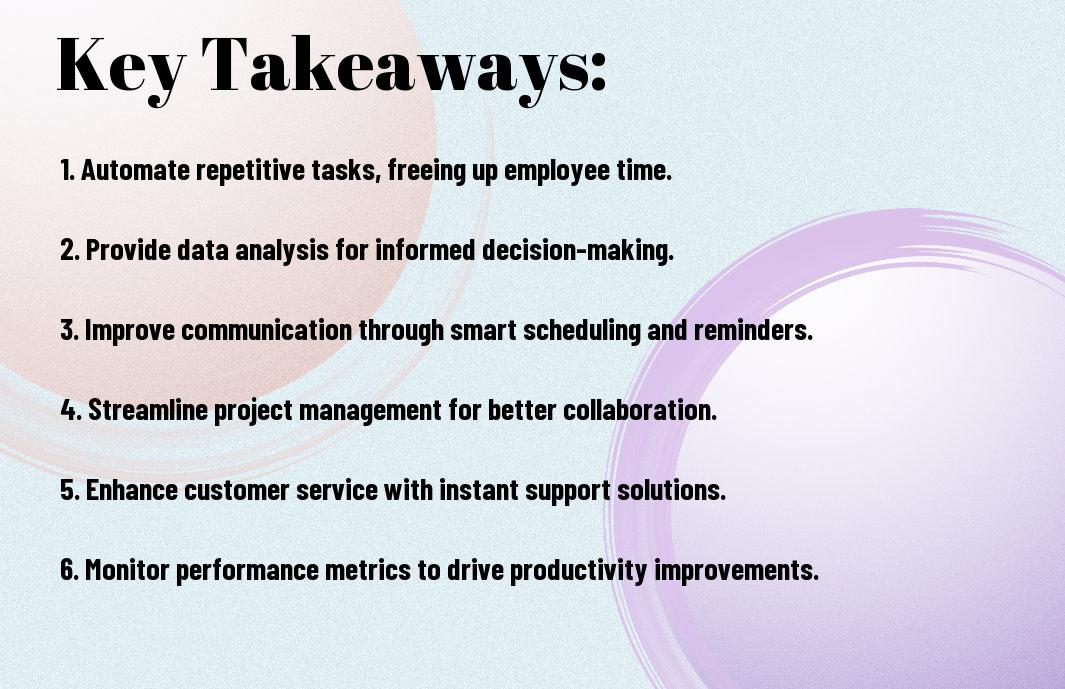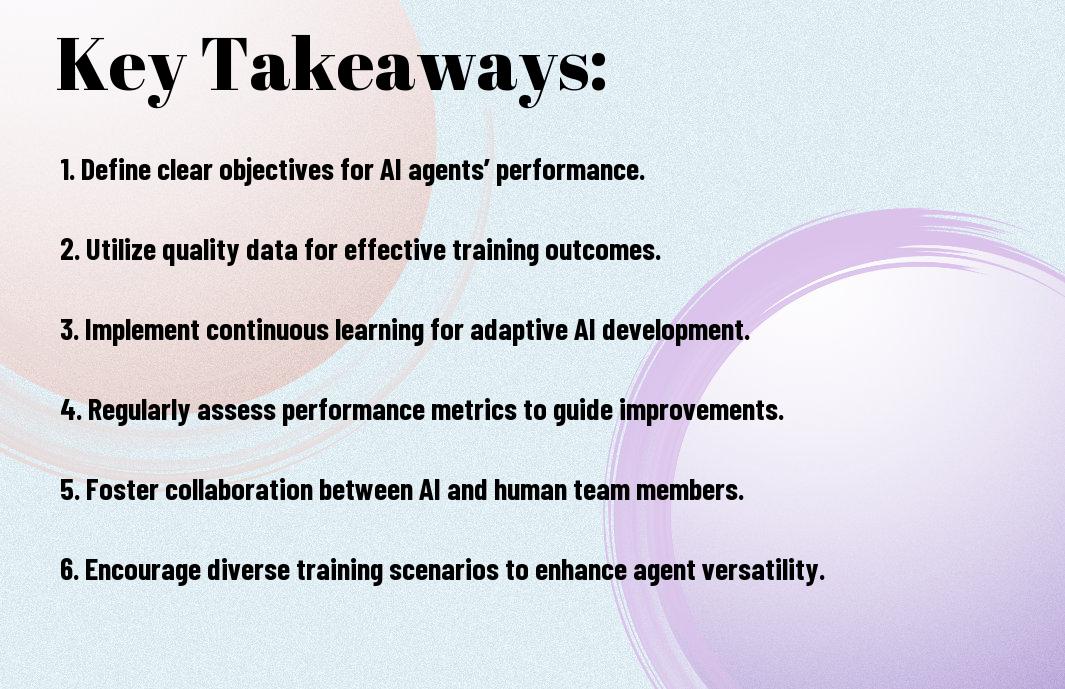As you explore the potential of artificial intelligence in your professional environment, you’ll discover how AI agents can significantly streamline your operations. Your workplace can benefit from automated tasks and data analysis, freeing up time for more complex problem-solving. To learn more about the impact of AI on productivity, visit 7 Ways AI Agents are Transforming Business Productivity and uncover the possibilities that await your organization, from enhanced customer service to improved decision-making processes.
Key Takeaways:
To maximize the benefits of AI agents in the workplace, consider the following points:
- Implementation of Automated Tasks can significantly reduce the time spent on mundane and repetitive jobs, allowing employees to focus on more Strategic Decision Making and creative problem-solving.
- Intelligent Assistants can enhance Customer Service by providing 24/7 support, answering frequent queries, and routing complex issues to human representatives, thus improving overall Response Time and customer satisfaction.
- Predictive Analytics and Data Analysis capabilities of AI agents can help organizations make by identifying trends, forecasting outcomes, and optimizing Resource Allocation to achieve better outcomes and increased efficiency.

Automation
Before implementing AI agents, your workplace likely relied on manual labor for various tasks, which can be time-consuming and prone to errors. With automation, you can allocate resources more efficiently, allowing your team to focus on high-priority tasks.
Streamlining Repetitive Tasks
The tedious nature of repetitive tasks can hinder your productivity and job satisfaction. AI agents can take over these tasks, freeing your time for more complex and creative work.
Enhancing Productivity
The key to maximizing your output lies in optimizing your workflow, and AI agents can help you achieve this. By analyzing your work patterns, they can identify areas where you can improve and provide personalized recommendations.
Streamlining your workflow with AI agents enables you to delegate tasks, set priorities, and track progress, ultimately leading to enhanced productivity and job satisfaction. As you work with AI agents, you will find that your workload becomes more manageable, allowing you to focus on high-value tasks and drive business growth.
Data Analysis
One of the key ways AI agents enhance workplace efficiency is through data analysis, allowing you to make informed decisions and streamline your operations.
Intelligent Data Processing
The ability of AI agents to process vast amounts of data quickly and accurately enables you to focus on higher-level tasks, freeing up your time and increasing productivity.
Informing Business Decisions
By analyzing data and identifying patterns, AI agents provide you with valuable insights that inform your business decisions, helping you to optimize your strategies and achieve your goals.
Data analysis performed by AI agents gives you a deeper understanding of your business, allowing you to identify areas of improvement and make data-driven decisions that drive growth and success, enabling you to stay ahead of the competition and achieve your objectives more efficiently.
Communication
To improve your workplace efficiency, AI agents play a significant role in enhancing communication. They facilitate seamless interactions, ensure clarity, and reduce misunderstandings, thereby streamlining your workflow.
AI-Powered Chatbots
Against the backdrop of traditional communication methods, AI-powered chatbots offer you a more efficient way to interact with customers and colleagues, providing prompt responses and automated support.
Enhanced Customer Support
An integral aspect of AI agents in communication is their ability to provide enhanced customer support, enabling you to address customer queries and concerns in a timely and personalized manner, which can significantly improve your customer satisfaction.
Further, when you implement AI-powered customer support systems, you can analyze customer interactions and identify patterns, allowing you to refine your support services and tailor them to meet the specific needs of your customers, ultimately leading to increased loyalty and retention.
Innovation
Not only do AI agents enhance workplace efficiency, but they also drive innovation. You can leverage AI to automate repetitive tasks, freeing your team to focus on creative problem-solving and experimentation.
Generating New Ideas
Across various industries, AI agents can analyze vast amounts of data, identifying patterns and connections that you may have missed, and generating new ideas for products, services, and processes.
Improving Existing Processes
For instance, you can use AI to optimize your workflows, streamlining tasks and eliminating bottlenecks, which enables your team to work more efficiently and effectively.
Even as you implement AI-driven process improvements, you’ll find that your team becomes more agile and adaptable, able to pivot quickly in response to changing market conditions or customer needs, and you’ll be able to measure the impact of these changes on your bottom line.

Organization
Despite the complexity of modern workplaces, AI agents can help you streamline your operations and improve overall efficiency. By automating routine tasks and providing valuable insights, AI agents enable you to focus on high-priority tasks and make data-driven decisions.
Task Management
Contrary to traditional methods, AI-powered task management systems allow you to prioritize and delegate tasks more effectively, ensuring that your team’s workload is balanced and productive. You can rely on AI agents to track progress, identify bottlenecks, and suggest improvements.
Scheduling and Planning
Similarly, scheduling and planning become more efficient with AI agents, as they can analyze your team’s availability, workload, and preferences to create optimal schedules and plans. You can use AI-driven tools to set realistic deadlines, allocate resources, and minimize conflicts.
Plus, with AI-powered scheduling and planning, you can respond quickly to changes and unexpected events, ensuring that your operations continue to run smoothly. You can also use AI agents to identify trends, forecast demand, and make informed decisions about resource allocation, ultimately leading to increased productivity and efficiency in your workplace.
Collaboration
All organizations strive for seamless collaboration, and AI agents can facilitate this by streamlining communication. You can learn more about enhancing efficiency with AI agents at How to 10x Efficiency with AI Agents: Transforming Workplace Communication, making your workplace more productive.
Teamwork and Cooperation
Beneath the surface of successful collaboration lies effective teamwork, which AI agents can significantly enhance by automating routine tasks, allowing you to focus on your core responsibilities and foster a sense of cooperation among your colleagues.
Cross-Functional Communication
Towards achieving better collaboration, you will find that AI agents play a significant role in facilitating cross-functional communication, enabling your teams to work together more effectively and make informed decisions.
Cooperation among different departments is vital for your organization’s success, and AI agents can facilitate this by providing a platform for seamless communication and data sharing, allowing you to break down silos and work towards common goals. As you implement AI agents in your workplace, you will notice a significant improvement in collaboration and overall productivity.
Summing up
Ultimately, as you explore the role of AI agents in your workplace, you’ll find that they enhance efficiency in numerous ways, streamlining tasks and improving productivity. You’ll discover that AI agents can automate routine tasks, analyze data, and provide insights, allowing you to make informed decisions and drive your business forward. By leveraging AI, you can optimize your workflow, reduce errors, and achieve your goals more effectively, transforming your workplace into a more efficient and innovative environment.
FAQ
Q: How do AI agents improve workflow management in the workplace?
A: AI agents enhance workflow management by automating routine tasks, streamlining processes, and providing real-time monitoring and analysis. This allows employees to focus on high-priority tasks, increasing productivity and efficiency. AI agents can also help identify bottlenecks and areas for improvement, enabling organizations to optimize their workflows and make data-driven decisions.
Q: Can AI agents assist with employee training and development in the workplace?
A: Yes, AI agents can play a significant role in employee training and development. They can provide personalized learning recommendations, offer interactive training sessions, and help track employee progress. AI-powered chatbots can also assist with onboarding new employees, answering frequently asked questions, and providing guidance on company policies and procedures. This helps to reduce the administrative burden on HR teams and ensures that employees have the skills and knowledge they need to excel in their roles.
Q: How do AI agents contribute to enhanced customer service and experience in the workplace?
A: AI agents can significantly enhance customer service and experience by providing 24/7 support, answering customer inquiries, and helping to resolve issues quickly and efficiently. AI-powered chatbots can also analyze customer data and behavior, enabling organizations to tailor their services and offerings to meet customer needs. Additionally, AI agents can help to automate routine customer service tasks, freeing up human customer support agents to focus on more complex and emotionally nuanced issues, leading to improved customer satisfaction and loyalty.












